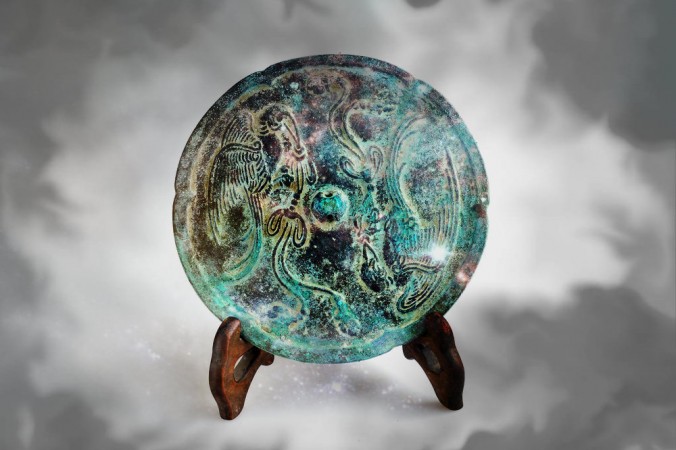Mysterious magic mirror in the Far East
Chinese and Japanese have long kept rare mirrors that are miraculous in that they are made of solid copper but can let light through.
Magic mirror in the Far East
The Chinese call them names that mean 'mirrors for light to penetrate '. For the West, they are simply called "magic mirrors ", and they have been causing scientists headaches for years.

Many ancient Chinese and Japanese bronze mirrors (like the mirror in the picture) look very ordinary, but in rare cases, they have strange properties that are both solid and transparent.(Shutterstock *; edited by Epoch Times)
The front of the mirror looks very normal. It is made of polished bronze to reflect the image of the person looking at the mirror. The back of the mirror is decorated with rich textures and patterns. The strange thing is that when shining light on a mirror, light reflects on a flat surface, carrying patterns on the back of it. That means the solid brass mirror becomes transparent.
Western scientists have been examining these mirrors since 1832 and it was not until a century later that they discovered the secret behind this mirror. Even in the East, it seemed that the knowledge to make these magic mirrors was still elusive, even if not completely out of reach.
About 1,200 years ago, this secret was recorded in a Chinese text entitled 'Record of Ancient Mirrors' , according to a 1988 article in The Unesco Courier magazine. But that book was lost a few centuries later. Today, Mr. Yamamoto Akihisa is rumored to be the last to be able to make this kind of magic mirror. The Kyoto Journal interviewed Akihisa, who learned the secret art from his father. Although this technique has been passed down for several generations by the hereditary in the Akihisa family, it has also been lost in half. His grandfather had to rediscover by studying the existing magic mirrors and recalling some of the methods his father had used.
In 1932, Sir William Bragg discovered the reason why the magic mirror reflected the pattern on the back of it.
The mirror, along with the patterned images on the back, was originally cast flat. Then the front of the mirror is bent into a convex surface by grinding, then the surface is polished. They are coated with mercury . These processes create warping and pressure, making the protrusions on the surface of the mirror very small for the naked eye to detect. These protrusions correspond to the back pattern of the mirror.
Mr. Bragg said ' Only the exaggerated effect of reflected light makes them appear'
 A clumsy attempt by nineteenth-century Western scientists to recreate the magic mirror of Chinese and Japanese people using pressure from inflatable pumps, taken from the end of 'Magic, Illusions and Scientific Diversions Stage Including Trick Photography '.(Public Domain)
A clumsy attempt by nineteenth-century Western scientists to recreate the magic mirror of Chinese and Japanese people using pressure from inflatable pumps, taken from the end of 'Magic, Illusions and Scientific Diversions Stage Including Trick Photography '.(Public Domain)
Scientists of the 19th century had a small success in reproducing this effect , though they did not understand the nature of this phenomenon, but they did so only by applying heat to the mirror (possibly damage the mirror) or pressure from the pump. They cannot reproduce the effect on a mirror that hangs freely without being exerted by external forces.
- Strange mysteries around the mirror
- The truth of 'making a haircut' about a mirror of 'life-threatening' 38 people
- The invention of a mirror with a much wider viewing angle than a conventional mirror
- The bronze mirror is still shiny after 1,900 years underground
- Why do we like to watch magic?
- 5 mysterious books about magic, curse and spell of ancient times
- Why do we find ourselves most beautiful in the mirror?
- The mirror of the
- Looking at mirrors can predict the disease
- Video: Smart mirror integrates computer screen
- Decipher the mysterious tsunami in the East Sea
- The terrible consequences of magic tricks are prevalent throughout netizens
 The truth about the mysterious red-haired giant at Lovelock Cave
The truth about the mysterious red-haired giant at Lovelock Cave Inunaki Tunnel: The haunted road leading into Japan's 'village of death'
Inunaki Tunnel: The haunted road leading into Japan's 'village of death' The mystery of the phenomenon of human reflection before dying
The mystery of the phenomenon of human reflection before dying 6 mysterious phenomena, although science has been developed for a long time, still cannot be answered
6 mysterious phenomena, although science has been developed for a long time, still cannot be answered